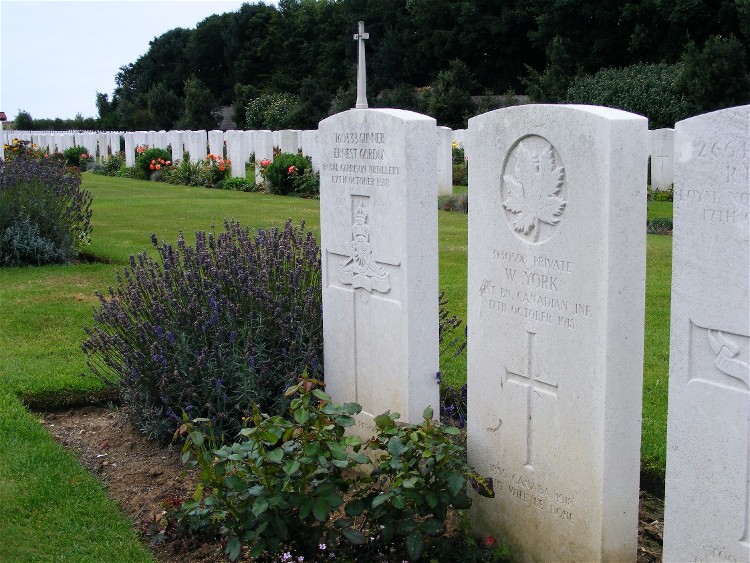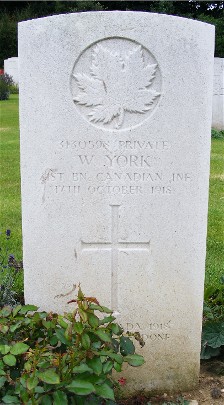|
William York In February of 2011 this webmaster was contacted by high school student Stephanie Chan, seeking assistance in doing some research for a history project. She had chosen a WW1 soldier as her topic and was enquiring about Pte William York of the 21st Battalion. I answered her questions and was able to provide her with suggestions as to where to look for more information, in addition to providing copies of some of the primary documents pertinent to her research. What follows is the result of her research, as well as her comments and thoughts about an event that took place almost 100 years ago. Thank you for sharing your research Stephanie, and for granting your permission to publish it here. For her efforts, Stephanie
was given a mark of 97% by her teacher. William York was a private in
the First World War. His regimental number
was 3130598 and he was part of the Canadian Infantry (Eastern Ontario Regiment).1 York was part of the
21st Battalion in the 4th Infantry Brigade of the 2nd Canadian Division.2 As a rifleman in the
trenches, he did not fight every day. Weeks could pass without any movement from the
enemy. However, when attacks occurred, they
were sudden and often deathly. Although York
was neither a high ranking officer in the military nor did he appear to have had a
significant impact in the war, he was a young Canadian soldier who died fighting for his
country in the Great War. York was born on April 29th,
1895 in Windsor, Ontario.3 He had blue eyes, dark
brown hair, and a medium complexion.4 Before the war, he lived
at 77 Monmouth Road in Walkerville, Ontario with his aunt, uncle, and cousins in Essex
County near Windsor.5 6 According to the 1911
Census of Canada, York's aunt was Anne Robinson, his uncle was William Robinson, and his
cousins were Mabel (age 23), Harold (age 19), and Hazel (age 19).7 Since York was living
with his aunt and uncle at the age of 16 and declared his aunt as his next-of-kin in his
attestation papers, it can be assumed that his parents were deceased.8 9 Before his
enlistment, York was a labourer, which is defined as someone who works with their hands or
is engaged in manual labour.10 William York came from a
Scottish background, and was a Methodist by religion.11 York was recruited during the
conscription crisis of 1917 because he was 22 years and 8 months old, which was between
the target ages of 20 to 45.12 At that time, York was 5
feet and 4 1/4 inches tall, his fully expanded chest measurement was 37 inches, and his
range of expansion was 35 1/2 inches.13 His medical examination
was completed on October 23, 1917 in Windsor, Ontario under the Military Service Act.14 A few months later, York
enlisted on January 4th, 1918 in London, Ontario as part of the process of call-ups which
began in January of 1918.15 16 York probably would have
been angry and frustrated at being conscripted into a war that he was unwilling to fight
in. He may also have been unsure about
leaving home because he was the youngest child among the cousins with whom he lived with. Additionally, York was quite careless and
rebellious. This was shown by the Daily
Orders of his battalion, which stated that he had a pay stoppage as punishment for losing
his equipment, including his iron rations, on September 24, 1918.17 On April 17, 1918, York
boarded the SS Scotian at Halifax, Nova Scotia, which was renamed the SS President Lincoln
later on. He arrived at the port in
Devonport, England for additional training before fighting on the western front in France. He trained in the Sandling Camp, near Hythe, Kent,
which was the same camp that the 21st Battalion trained in from May to September of 1915. York boarded a ship at Folkestone to cross the
English Channel to France, and disembarked at Le Havre, France, where he was processed at
the Canadian Infantry Base Depot. Originally,
York was drafted into the 1st Depot Battalion, Western Ontario Regiment Depot in Canada,
but was posted to the 21st Battalion after training in England. As seen from the Daily Orders of the 21st
Battalion, York was transferred from the 1st Canadian Battalion to the 21st Battalion on
September 30, 1918.18 William York died on October
17th, 1918 at the age of 23 from shrapnel wounds received during the course of action.19 His wounds were
caused by an artillery shell that was engineered to explode in the air, showering down
small balls of lead at high speeds. He was
wounded during the Battle of Cambrai in October of 1918, which was part of Canada's
Hundred Days.20 The 21st Battalion
was stationed in the Iwuy region, near Cambrai, and participated actively in the battle.21 The specific date on
which York was wounded is not known, but his injury most likely occurred on October 11th
since a lot of fighting and shell fire reportedly occurred on that day.22 On October 11th, the
21st Battalion was utilised as the right attacking fighting unit of the 4th Canadian
Infantry Brigade.23 From 05:30 onwards,
the enemy shelled the area with high explosives and gas, and the 4th Brigade began their
attack at 09:00.24 It was reported that the
enemy artillery reacted immediately, returning artillery fire and machine gun fire that
caused many casualties in the first half hour.25 York was probably
wounded by an artillery shell during this time. After
he was wounded, he was taken to a Field Ambulance near the frontline, then transferred to
a Casualty Clearing Station for emergency surgery, and transferred again to the 2nd
Australian General Hospital in Boulogne, France. The
2nd Australian General Hospital was a large tented hospital that treated many soldiers
with battle casualties from the war.26 A few days after being
wounded, York died in the hospital and was buried in a nearby cemetery in Wimille called
the Terlincthun British Cemetery.27 His grave reference is
VI.A.2.28
In retrospect, William York's
death was tragic because he was only part of the 21st Battalion for a couple of weeks
before his death. His quick death may have
been a result of the rushed training that conscripted soldiers often received or because
of the indifferent attitudes of men who had been conscripted. Regardless of the fact that William York was only
a soldier for a few months and had no lasting individual impact on the war, he will always
be remembered for his great sacrifices as a Canadian in the First World War.
Foot Notes: 1 Commonwealth
War Graves Commission, "Commonwealth War Graves Commission Casualty Details", http://www.cwgc.org/search/casualty_details.aspx?casualty=4027851
(accessed February 8, 2011). 2 Richard
Laughton, "Canadian Expeditionary Force Study Group," 21st Battalion, http://www.cefresearch.com/matrix/Army%20Corps/Divisions/2nd%20Division/4th%20Infantry%20Brigade/21st%20Battalion.htm
(accessed February 12, 2011). 3 Attestation
paper: York, William, RG 150, Accession 1992-93/166, Box 10640 - 42, Library and Archives
of Canada. 4 Ibid.
5 Ibid.
6 Automated
Genealogy, "1911 Census of Canada," Automated Genealogy, http://automatedgenealogy.com/census11/
(accessed February 12, 2011). 7 Ibid.,
1. 8 Ibid.
9 Attestation
paper: York, William, RG 150, Accession 1992-93/166, Box 10640 - 42, Library and Archives
of Canada. 10 Ibid. 11 Automated
Genealogy, "1911 Census of Canada," Automated Genealogy, http://automatedgenealogy.com/census11/
(accessed February 12, 2011). 12 Attestation
paper: York, William, RG 150, Accession 1992-93/166, Box 10640 - 42, Library and Archives
of Canada. 13 Ibid. 14 Ibid. 15 Ibid., 2. 16 The Canadian
Encyclopedia Historica-Dominion, "Conscription: World War I," The Canadian
Encyclopedia, http://www.histori.ca/peace/index.do
(accessed February 14, 2011). 17 Part II
Orders - 21st Canadian Infantry Battalion, RG-150, R611-3-E & F, Library and Archives
Canada. 18 Ibid. 19 The War
Graves Photographic Project, "The War Graves Photographic Project," War Grave
and Memorial Photographs supplied by The War Graves Photographic Project, http://www.twgpp.org/index.php
(accessed February 14, 2011). 20 Library and
Archives Canada, "Canal-du-Nord and Cambrai," Canada and the First World War, hhttp://www.collectionscanada.gc.ca/firstworldwar/index-e.html
(accessed February 16, 2011). 21 Richard
Laughton, "Canadian Expeditionary Force Study Group," 21st Battalion, http://www.cefresearch.com/matrix/Army%20Corps/Divisions/2nd%20Division/4th%20Infantry%20Brigade/21st%20Battalion.htm
(accessed February 12, 2011). 22 War Diaries
- 21st Canadian Infantry Battalion, RG9, Militia and Defence, Series III-D-3, Volume 4931,
Library and Archives Canada. 23 Ibid. 24 Stephen
Nichol, Ordinary Heroes: Eastern Ontario's 21st Battalion C.E.F. in The Great War
(Privately Published, 2008), 202. 25 Ibid., 4. 26 ANZAC Day
Commemoration Committee (Qld) Incorporated, "Australian WW1 Hospitals," Casualty
Clearance WW1 Hospitals, http://www.anzacday.org.au/history/ww1/anecdotes/hospitals.html
(accessed February 13, 2011). 27 Commonwealth
War Graves Commission, "Commonwealth War Graves Commission Casualty Details", http://www.cwgc.org/search/casualty_details.aspx?casualty=4027851
(accessed February 8, 2011). 28 Ibid. Works Cited ANZAC Day Commemoration
Committee (Qld) Incorporated. "Australian WW1 Hospitals." Casualty Clearance -
The WW1 Hospitals. http://www.anzacday.org.au/history/ww1/anecdotes/hospitals.html
(accessed February 13, 2011). Automated Genealogy.
"1911 Census of Canada." Automated Genealogy. http://automatedgenealogy.com/census11/
(accessed February 12, 2011). Commonwealth War Graves
Commission. "Commonwealth War Graves Commission Casualty Details." http://www.cwgc.org/search/casualty_details.aspx?casualty=4027851
(accessed February 8, 2011). Historica Foundation.
"The Conscription Crisis of 1917." Historica Pease and Conflict. http://www.histori.ca/peace/index.do
(accessed February 14, 2011). Laughton, Richard.
"Canadian Expeditionary Force Study Group." 21st Battalion. http://www.cefresearch.com/matrix/Army%20Corps/Divisions/2nd%20Division/4th%20Infantry%20Brigade/21st%20Battalion.htm
(accessed February 12, 2011). Library and Archives Canada.
"Canal-du-Nord and Cambrai." Canada and the First World War. http://www.collectionscanada.gc.ca/firstworldwar/index-e.html(accessed
February 16, 2011). Library and Archives Canada.
RG-150, R611-3-E & F. Part II Orders - 21st Canadian Infantry Battalion. Library and Archives Canada.
RG9, Militia and Defence, Series III-D-3, Volume 4931. War Diaries - 21st Canadian
Infantry Battalion. Library and Archives of
Canada. RG 150, Accession 1992-93/166, Box 10640 - 42. Attestation paper: York,
William. Lloyd, Al. "The 21st
Battalion CEF." The 21st Battalion CEF. http://21stbattalion.ca/page1.html (accessed February 12, 2011). Nichol, Stephen. Ordinary
Heroes: Eastern Ontario's 21st Battalion C.E.F. in The Great War. Privately Published,
2008. The Canadian Encyclopedia
Historica-Dominion. "Conscription: World War I." The Canadian Encyclopedia. http://www.thecanadianencyclopedia.com/index.cfm
(accessed February 14, 2011). The War Graves Photographic
Project. "The War Graves Photographic Project." War Grave and Memorial
Photographs supplied by The War Graves Photographic Project. http://www.twgpp.org/index.php
(accessed February 14, 2011). Veterans Affairs Canada.
"In memory of Private William York." Veterans Affairs Canada. http://www.veterans.gc.ca/eng
(accessed February 12, 2011). |




